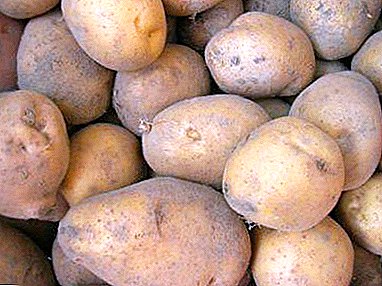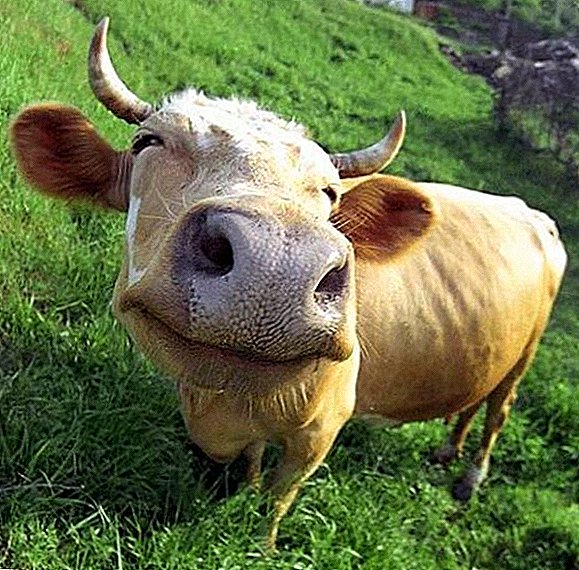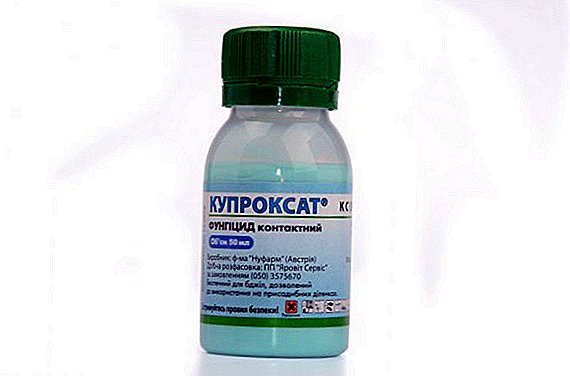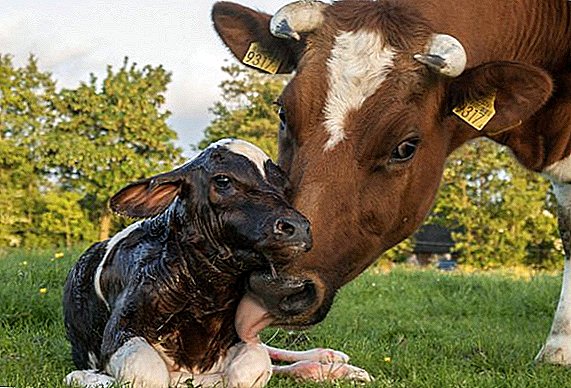 For livestock breeders, it is important to preserve and grow all the young. This is especially important for cattle, because a cow gives birth to only one calf at a time.
For livestock breeders, it is important to preserve and grow all the young. This is especially important for cattle, because a cow gives birth to only one calf at a time.
What to do if the calf was born with hypotrophy, and what are the reasons for this.
What is congenital malnutrition?
Calves' hypotrophy is a congenital non-infectious disease that has arisen as a result of malnutrition of the mother of a cow. The cubs with him are born with underweight, weak and susceptible to various ailments. 
Causes
A cow may have a calf born with congenital hypotrophy for the following reasons:
- lack of feed;
- defective food. The imbalance between the ratio of proteins - carbohydrates. Lack of vitamins and minerals;
- violation of conditions of detention. Lack of light, lack of walking and other deviations from the norms of content;
- bad ecology. This phenomenon often affects the metabolism of the mother of the cow, which, in turn, has a negative impact on the offspring;
- frequent stress. Infections, multiple vaccinations and other treatments during pregnancy;
- over exploitation;
- closely related crossbreeding;
- pathology of pregnancy. Violation of the placental circulation of the fetus, pregnancy toxicosis;
- preterm labor;
- early pregnancy. Puberty in cows occurs at the age of 8-9 months, but they should be seated or inseminated much later - at 15-16 months. When their body will be better prepared for pregnancy and childbirth. The weight of the animal at this age should be 350 kg, and during the period of birth - 400 kg.

Important! You can not keep together the young of different sex, if they have to come or have already come puberty.
Symptoms
Determine a calf with congenital hypotrophy can be on the following grounds:
- low body weight. A healthy calf has a body weight of 7–9% of the cow’s live weight. The weight of the newborn in 60-70% of the norm indicates its hypertrophy;
- body disproportion;
- weakness, lethargy. Such a cub sucks poorly, for a long time (more than an hour after birth) does not get up on its feet, it has an inconsistency of movements;
- poor skin condition. Such individuals usually have dry, slightly elastic skin, folds that do not stretch for a long time, rare hard wool, poorly developed subcutaneous fat;
- redness and erosion on the nose, gums;
- weak reaction to external influences. When nipping in the croup, a healthy calf immediately jumps up or jumps off, and the patient slows down a bit with reactions;
- pallor of mucous membranes;
- hemoglobin, leukocytes and red blood cells are below their standards;
- eye drooping, lacrimation;
- low body temperature;
- multiple fertility (rare in cows);
- underdeveloped incisors (four or less instead of six);
- delayed original feces;
- frequent shallow breathing;
- cardiopalmus.

Did you know? Pregnancy in cows lasts 9 months, and usually they give birth to no more than one calf per year. The probability of having twins is about 1 in 1000 from all calving. The maximum number of births for one childbirth - four calves.
Diagnostics
To establish the reasons for the frequent birth of young with hypotrophy can also conduct the following studies:
- analysis of the feeding and maintenance of body cows;
- analysis of breeding work, identifying its shortcomings;
- bacteriological and virological study of dead calves. Conducted to eliminate infections in the household.

Pathological changes
Calp hypotrophy leads to the following pathologies:
- growth and developmental delay;
- impaired metabolism;
- weak immunity;
- indigestion, toxicosis;
- hypoxia. It is often observed in the first few days after birth and is caused by cardiac or pulmonary insufficiency.
We advise you to find out why the calf is sluggish and eats poorly.
Comprehensive treatment
For the treatment of malnutrition in calves using a number of measures. 
Heating young
In the presence of hypotrophy, heating is of great importance. To do this, use different heating devices - heater, heater lamp and others. You can simply heat the room to raise the temperature. The calf area must be dry and free from drafts. The room should have a good bedding that will protect from moisture and cold.
Did you know? Calves born from cows fed low-protein foods may have reduced heat generation capacity.
Feeding
If calves have reflexive sucking, then they are applied to the udder, which produces the greatest amount of colostrum. In the absence of such a reflex, the cubs are fed in small portions of warm colostrum with the help of a nipple. For a good food processing using digestive enzymes. As such enzymes use the gastric juice of horses, which give 40 ml twice a day. You can also use artificial gastric juice, which is given 20 minutes before a meal, 50-100 ml. 
Introduction of vitamins
As a therapeutic treatment, blood is transfused to young animals at the rate of 1 ml / kg of weight from completely healthy cows, and vitamins A, D, E and glucose are also administered. Glucose is recommended to add vitamins of group B.
For weight gain, it is recommended to use injections of the vitamin veterinary medicine "Trivit" (vitamins A, D3, E), which are given once a week for a month in an amount of 1.5-2 ml per injection.
Read about what vitamins calves need for rapid growth.
It is recommended to inject injections the preparations "Aminopeptide", "Hydrolysine" or "Microvits", containing the amino acids and microelements necessary for growth. Aminopeptid injections are made up to 50-250 ml per day. "Hydrolysin" can be applied intravenously, intramuscularly or under the skin for 3-5 days in the amount of 50-150 ml per day. The scheme of use of the drug "Microvitam" is as follows: a month for calves injections of 12 ml per head with an interval of 10 days to three months of age.  For the oppression of pathogenic bacteria, experts recommend Bacilikhin, Biovit, and other stimulants.
For the oppression of pathogenic bacteria, experts recommend Bacilikhin, Biovit, and other stimulants.
Important! If calves are not able to feed on their own four hours after their birth, then probe feeding should be organized.
Prevention
To prevent the appearance of hypotrophy in youngsters, experts recommend adhering to the following rules:
- comply with all regulations and recommendations on the feeding and maintenance of pregnant cows and young. The diet of pregnant cows should not only be nutritious, but also contain the necessary complex of vitamins and minerals, especially in the second half of pregnancy;
- regular outdoor outings for livestock;
- it is important, when mating, to choose the right producers, not to allow mating of immature, too young females or males, which are close in animal kinship;
- compliance with hygiene during childbirth;
- recommend using protein hydrolysates for four consecutive days after birth, then twice a week;
- it is necessary to reduce the stress in cows to calving to a minimum. To prevent lice and parasites.

Learn more about the stages of feeding a calf.The birth of young cattle with hypotrophy is not uncommon. This disease can develop due to improper feeding of calves after childbirth. If this happened (and more than once), then it is necessary to analyze the feeding and the conditions of keeping pregnant cows and young animals, the breeding work carried out and eliminate the drawbacks, to apply preventive measures.












